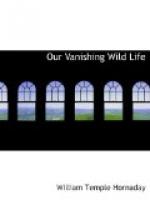Does are sometimes dangerous, and inflict serious damage by rising on their hind feet and viciously striking with their sharp front hoofs. These tendencies in American deer are mentioned here as a duty to persons who may desire to breed deer for profit.
The Red Deer of Europe.—Anyone who has plenty of natural forest food for deer and a good market within fair range, may find the European red deer a desirable species. It is of size smaller, and more easily managed, than the wapiti; and is more easily marketed because of its smaller size. As a species it is hardy and prolific, and of course its venison is as good as that of any other deer. Live specimens for stocking purposes can be purchased of S.A. Stephan, Agent for Carl Hagenbeck, Cincinnati Zoological Gardens, or of Wenz & Mackensen, Yardley, Pa., at prices ranging from $60 to $100 each, according to size and age. At present the supply of specimens in this country on hand for sale is very small.
The Fallow Deer.—This species is the most universal park deer of Europe. It seems to be invulnerable to neglect and misuse, for it has persisted through countless generations of breeding in captivity, and the abuse of all nations. In size it is a trifle smaller than our white-tailed deer, with spots in summer, and horns that are widely flattened at the extremities in a very interesting way. It is very hardy and prolific, but of course it can not stand everything that could be put upon it. It needs a dry shed in winter, red clover hay and crushed oats for winter food; and no deer should be kept in mud. As a commercial proposition it is not so meaty as the white-tail, but it is less troublesome to keep. The adult males are not such vicious or dangerous fighters as white-tail bucks. Live specimens are worth from $50 to $75. The Essex County Park Commissioners (Orange, New Jersey) have had excellent success with this species. In 1906 they purchased twenty-five does and four bucks and placed them in an enclosure of 150 acres, on a wooded mountain-side. In 1912 they had 150 deer, and were obliged to take measures for a disposal of the surplus. Messrs. Wenz & Mackensen, keep an almost continuous supply of fallow deer on hand for sale.
The Indian Sambar Deer.—I have long advocated the introduction in the southern states, wherever deer can be protected, of this great, hulking, animated venison-factory. While I have not delved deeply into the subject of weight and growth, I feel sure from casual observations of the growth of about twenty-five animals that this species produces more venison during the first two years of its life than any other deer with which I am acquainted. I regard it as the greatest venison-producer of the whole Deer Family; and I know that is a large order. The size of a yearling is almost absurd, it is so great for an animal of tender years. When adult, the species is for its height very large and heavy.




